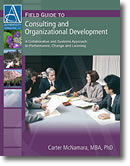What is an Organization?
© Copyright Carter McNamara, MBA, PhD, Authenticity Consulting, LLC.
This Article is in a Series About Understanding Organizational Structures and Design
This article is the first in the series which includes:
- What is an Organization?
2. What Makes Each Organization Unique
3. How They’re the Same: They’re Systems
4. Basic Overview of Life Cycles in Organizations
5. Basic Overview of Organizational Culture
6. Legal Forms and Traditional Structures of Organizations
7. Driving Forces and a New Organizational Paradigm
8. Emerging Nature and New Organizational Structures and Design
9. Basic Guidelines for Organizational Design
10. Wrap Up: Grasping the Big Picture in Organizations (video)
Sections of This Article Include
- Basic Definition
- Organization’s Purpose and Priorities
- Critical Roles of Leadership and Communications
Basic Definition
Most of us have worked in an organization of people — even a family is a type of organization. The word is so widely used that its meaning can sometimes be lost. The word means a collection of resources that are working together somehow to achieve a common purpose. When we talk about an organization, we are usually referring to a group of people.
Organizations of people come in many forms. They might be a random group of people who spontaneously came together to address a short-term need, such as collecting litter along a certain stretch of road. Or, it might be a carefully collected, aligned and integrated group of people who came together for the long-term to address a long-term need, such as stopping poverty in a certain country.
An overall organization can have a variety of small organizations within it, for example, various departments and teams of people. The way that people work together in an organization depends on a variety of factors, including the values in their culture, the nature of their leadership and types of current needs they are working to address. See What Makes Each Organization Unique.
Let us look at some other definitions of the word “organization” and some more about how an organization works toward a common purpose.
Organization’s Purpose and Priorities
Mission
All of the people in an organization should be working toward a common purpose. That purpose is often referred to as the mission. The mission might be implied to its members or explicitly expressed to them.
When explicitly expressed, it is often in the form of a mission statement. The statement is often reviewed during a process called strategic planning.
Vision
The organization’s vision is an image of what success would look like at some point in the future, both
for the people that the organizations serves and for the organization itself. It can be very inspirational and motivational to explicitly articulate that vision in a statement like the mission statement during strategic planning.
Values
The organization’s values are the overall priorities in the nature of how the organization wants to work
toward its mission. Values can be reflected in how the people in the organization are actually working together. These might be referred to as real or enacted values. Values can also be about how the organization wants it members to work together. These might be referred to as desired values.
Strategic Priorities
These are the overall, most important matters and activities for members to attend to, when working toward the mission. Similar to the mission, vision and values, they might be implied or explicit among members. The priorities might be associated with assignments for who is address which ones and by when. The priorities are often referred as “strategic goals” during a strategic planning process.
Thus, it could seem to be a major challenge when working to lead, manage or improve an organization. Fortunately, there are some things in common to all types of organizations — because they all are systems. We will review more about systems later in this series of articles.
Learn More in the Library’s Blogs Related to Organizations
In addition to the information on this current page, see the following blogs which have posts related to organizations. Scan down the blog’s page to see various posts. Also see the section “Recent Blog Posts” in the sidebar of the blog or click on “next” near the bottom of a post in the blog.
- Library’s Consulting and Organizational Development Blog
- Library’s Leadership Blog
- Library’s Nonprofit Capacity Building Blog
For the Category of Organizational Development:
To round out your knowledge of this Library topic, you may want to review some related topics,
available from the link below. Each of the related topics includes free, online resources.
Also, scan the Recommended Books listed below. They have been selected for their relevance and highly practical nature.
 Sections of this topic
Sections of this topic















